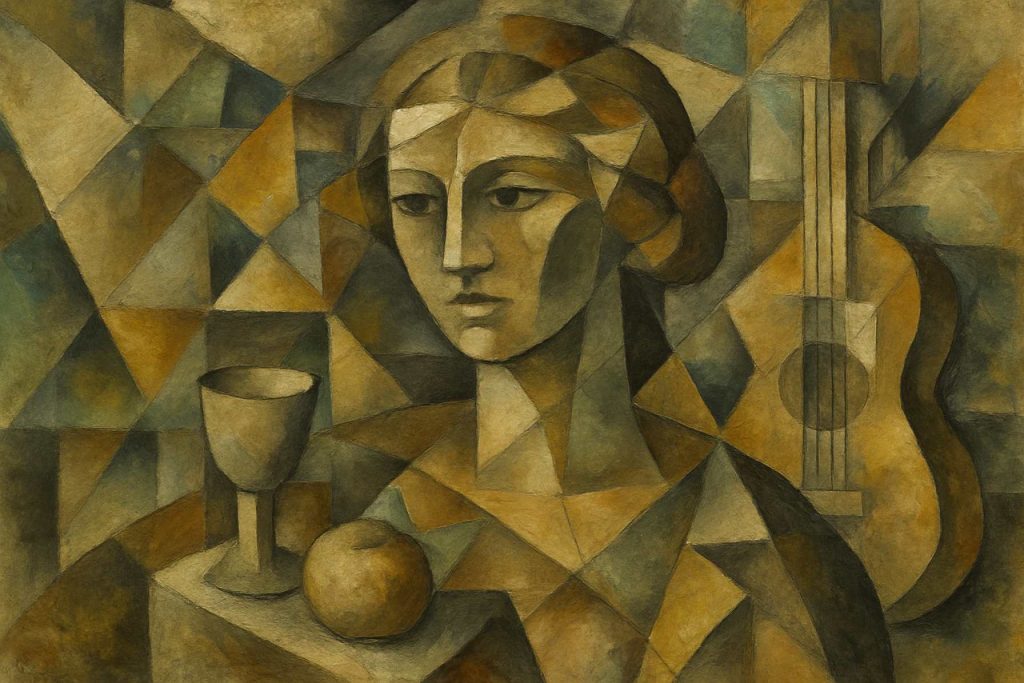
Cubism: The Radical Art Movement That Redefined Visual Reality. Discover How Picasso, Braque, and Their Contemporaries Changed the Way We See the World.
- Origins and Historical Context of Cubism
- Key Figures: Picasso, Braque, and Beyond
- Philosophical Foundations and Influences
- Analytical Cubism: Deconstructing Form
- Synthetic Cubism: Reconstructing Reality
- Cubism’s Impact on Sculpture and Architecture
- Techniques, Materials, and Innovations
- Critical Reception and Controversies
- Cubism’s Global Influence and Legacy
- Contemporary Interpretations and Ongoing Relevance
- Sources & References
Origins and Historical Context of Cubism
Cubism emerged in the early 20th century as a revolutionary movement in the visual arts, fundamentally altering the trajectory of modern art. Its origins are closely tied to the intellectual and cultural ferment of pre-World War I Europe, particularly in Paris, which was then the epicenter of avant-garde artistic innovation. The movement is most commonly associated with two pioneering artists: Pablo Picasso and Georges Braque. Their collaborative explorations between 1907 and 1914 laid the groundwork for Cubism’s radical departure from traditional modes of representation.
The roots of Cubism can be traced to several converging influences. One significant precursor was the work of Paul Cézanne, whose late paintings deconstructed natural forms into geometric shapes and emphasized the two-dimensionality of the canvas. Cézanne’s approach inspired Picasso and Braque to further question the conventions of perspective and modeling that had dominated Western art since the Renaissance. Additionally, the influx of non-Western art into Parisian collections—particularly African masks and sculptures—provided new models for abstraction and the simplification of forms.
The historical context of Cubism’s emergence was marked by rapid technological, scientific, and social change. The early 1900s saw the rise of photography, cinema, and new theories in physics, such as Einstein’s relativity, which challenged established notions of space and time. Artists sought to reflect these shifts by developing visual languages that could express the complexity and dynamism of modern life. Cubism’s fragmented, multi-perspective approach was a direct response to these broader cultural transformations.
Cubism is generally divided into two phases: Analytic Cubism (c. 1907–1912), characterized by the deconstruction of objects into monochromatic, interlocking planes, and Synthetic Cubism (c. 1912–1914), which introduced brighter colors, simpler shapes, and collage elements. The movement quickly attracted a circle of artists, including Juan Gris, Fernand Léger, and Robert Delaunay, and influenced fields beyond painting, such as sculpture, architecture, and design.
The significance of Cubism in art history is recognized by major institutions worldwide, including The Museum of Modern Art and Tate, both of which hold extensive collections and research on Cubist works. These organizations underscore Cubism’s role as a catalyst for subsequent modernist movements and its enduring impact on the visual arts.
Key Figures: Picasso, Braque, and Beyond
Cubism, one of the most influential art movements of the 20th century, was pioneered by two central figures: Pablo Picasso and Georges Braque. Their collaboration in the early 1900s fundamentally transformed the visual language of painting and sculpture, introducing a radical approach to representing reality. Picasso, a Spanish artist renowned for his versatility and innovation, and Braque, a French painter with a background in Fauvism, began working closely in Paris around 1907. Together, they developed what is now known as Analytic Cubism, characterized by the deconstruction of objects into geometric forms and the use of a limited color palette to emphasize structure over detail.
Picasso’s painting Les Demoiselles d’Avignon (1907) is often cited as a foundational work of Cubism, breaking away from traditional perspective and foreshadowing the movement’s emphasis on multiple viewpoints. Braque’s subsequent works, such as Houses at L’Estaque (1908), further explored the fragmentation of form and the flattening of pictorial space. The close partnership between Picasso and Braque lasted until the outbreak of World War I, during which time they produced a prolific body of work that laid the groundwork for modern abstract art.
Beyond Picasso and Braque, several other artists played significant roles in the evolution and dissemination of Cubism. Juan Gris, a Spanish painter, is often regarded as the third major figure of the movement. Gris’s approach, sometimes called Synthetic Cubism, introduced brighter colors, clearer compositions, and the incorporation of collage elements, expanding the movement’s visual vocabulary. Fernand Léger, another key contributor, brought a mechanistic and dynamic sensibility to Cubism, influencing later developments in both painting and design.
- Pablo Picasso: Widely considered one of the most important artists of the 20th century, Picasso’s innovations in Cubism and other styles are recognized globally. His works are held in major collections, including those of the Museo Nacional Centro de Arte Reina Sofía and Musée Picasso Paris.
- Georges Braque: Braque’s contributions to Cubism are celebrated for their subtlety and depth, with his works featured in institutions such as the Centre Pompidou.
- Juan Gris: Gris’s precise and colorful compositions helped define the later phases of Cubism, and his legacy is preserved in museums like the Museo Nacional Thyssen-Bornemisza.
- Fernand Léger: Léger’s unique interpretation of Cubism bridged the gap between abstraction and modern design, with his works displayed at the Centre Pompidou.
Together, these artists not only shaped the trajectory of Cubism but also laid the foundation for much of modern art, influencing generations of creators and movements worldwide.
Philosophical Foundations and Influences
Cubism, emerging in the early 20th century, was not merely an artistic style but a profound philosophical shift in the perception and representation of reality. Its philosophical foundations are deeply rooted in the intellectual currents of its time, particularly in the realms of epistemology, phenomenology, and the evolving understanding of visual perception. The movement’s leading figures, Pablo Picasso and Georges Braque, were influenced by contemporary developments in science and philosophy, seeking to transcend the limitations of traditional perspective and to depict objects from multiple viewpoints simultaneously.
One of the central philosophical influences on Cubism was the work of French philosopher Henri Bergson, whose ideas about time, memory, and subjective experience challenged the static, mechanistic worldview of the 19th century. Bergson’s emphasis on intuition and the fluidity of perception resonated with Cubist artists, who sought to capture the dynamic nature of seeing and knowing. This approach aligned with the broader intellectual movement away from positivism and towards a more fragmented, multifaceted understanding of reality.
Cubism was also shaped by the scientific discoveries of the era, particularly those related to optics and the nature of vision. The movement paralleled the work of physicists such as Albert Einstein, whose theories of relativity questioned the absoluteness of space and time. Cubist artists, in turn, abandoned the single-point perspective that had dominated Western art since the Renaissance, instead presenting objects as if seen from several angles at once. This radical approach reflected a new philosophical stance: reality is not a fixed entity, but a construct shaped by the observer’s position and experience.
The influence of Paul Cézanne, often regarded as a precursor to Cubism, was also significant. Cézanne’s analytical approach to form and his attempts to depict the underlying structure of objects inspired Cubists to deconstruct and reassemble visual reality. This analytical method was underpinned by a philosophical inquiry into the nature of perception and representation, echoing questions raised by phenomenologists such as Edmund Husserl.
Institutions such as the Centre Pompidou in Paris and the Museum of Modern Art in New York have extensively documented the philosophical and intellectual context of Cubism, highlighting its role as a catalyst for modernist thought. Through its engagement with contemporary philosophy and science, Cubism fundamentally redefined the relationship between art, reality, and perception, laying the groundwork for subsequent avant-garde movements.
Analytical Cubism: Deconstructing Form
Analytical Cubism, the initial and most intellectually rigorous phase of the Cubist movement, emerged between 1908 and 1912, primarily through the collaborative efforts of Pablo Picasso and Georges Braque. This period is characterized by a systematic deconstruction of objects into their fundamental geometric components, such as cubes, spheres, and cones. Rather than depicting subjects from a single viewpoint, Analytical Cubism sought to represent multiple perspectives simultaneously, fragmenting forms and reassembling them on a two-dimensional plane. This radical approach challenged traditional notions of perspective and pictorial space, fundamentally altering the trajectory of modern art.
The process of Analytical Cubism involved breaking down natural forms into a series of overlapping planes and facets, often rendered in a muted palette of browns, grays, and ochres. This restrained color scheme allowed artists to focus attention on the structure and spatial relationships within the composition, rather than on surface appearance. The resulting works, such as Picasso’s “Ma Jolie” and Braque’s “Violin and Palette,” appear almost abstract, yet they retain subtle cues to the original subject matter. The interplay of light and shadow is minimized, further flattening the pictorial space and emphasizing the autonomy of the canvas as an object in itself.
Analytical Cubism was not merely a stylistic innovation but also a conceptual one. By dissecting and reconfiguring visual reality, Picasso and Braque invited viewers to engage in a more active process of perception, reconstructing the depicted forms in their minds. This intellectual engagement was a deliberate departure from the illusionism of earlier Western art, aligning with broader philosophical currents that questioned the nature of reality and representation. The movement’s emphasis on analysis and structure resonated with contemporary developments in mathematics and science, reflecting a zeitgeist of inquiry and discovery.
The influence of Analytical Cubism extended beyond painting, impacting sculpture, architecture, and even literature. Its legacy can be traced in the work of artists such as Juan Gris and Fernand Léger, as well as in the evolution of abstract art throughout the twentieth century. Major museums and institutions, including the Museum of Modern Art and the Tate, house significant collections of Cubist works, underscoring the enduring importance of this movement in the history of art. Analytical Cubism’s methodical deconstruction of form remains a touchstone for artists and scholars exploring the boundaries of visual language.
Synthetic Cubism: Reconstructing Reality
Synthetic Cubism, emerging around 1912, represents the second major phase of the Cubist movement, following the earlier Analytical Cubism. While Analytical Cubism focused on deconstructing objects into fragmented, overlapping planes to analyze their structure, Synthetic Cubism shifted towards reconstructing reality by synthesizing new forms and incorporating diverse materials. This phase was pioneered by artists such as Pablo Picasso and Georges Braque, who began to experiment with collage, papier collé (pasted paper), and the integration of everyday objects into their compositions.
A defining characteristic of Synthetic Cubism is its use of simpler shapes, brighter colors, and a greater emphasis on flatness and surface. Artists moved away from the muted palettes and intricate faceting of Analytical Cubism, instead opting for bold, often contrasting colors and larger, more legible forms. This allowed for a clearer depiction of objects, even as they remained abstracted and fragmented. The introduction of collage was revolutionary: Picasso’s 1912 work “Still Life with Chair Caning” is often cited as the first modern collage, incorporating oilcloth and rope to blur the boundaries between painting and sculpture.
Synthetic Cubism also marked a conceptual shift in the understanding of representation. Rather than merely analyzing and breaking down visual reality, artists began to construct new realities by assembling disparate elements. This approach questioned the very nature of art and illusion, as the inclusion of real-world materials—such as newspaper clippings, wallpaper, and fabric—challenged traditional notions of artistic authenticity and mimesis. The movement’s innovations had a profound influence on later developments in modern art, including Dada, Surrealism, and the broader use of mixed media.
The impact of Synthetic Cubism extended beyond painting and collage. Its principles influenced sculpture, graphic design, and even architecture, as artists and designers explored new ways to represent and reconstruct the world. The movement’s legacy is preserved in major museum collections and continues to be studied by institutions such as the Museum of Modern Art and the Tate, both of which hold significant works from this period and provide educational resources on Cubism’s evolution.
In summary, Synthetic Cubism was a pivotal development in early twentieth-century art, redefining the relationship between reality and representation. By reconstructing reality through synthesis and innovation, Cubist artists laid the groundwork for much of modern and contemporary art’s experimental spirit.
Cubism’s Impact on Sculpture and Architecture
Cubism, initially developed as a revolutionary approach to painting in the early 20th century by artists such as Pablo Picasso and Georges Braque, profoundly influenced not only the visual arts but also sculpture and architecture. The movement’s core principles—fragmentation of form, multiple perspectives, and the abstraction of objects into geometric shapes—were quickly adopted and adapted by sculptors and architects seeking to break away from traditional representational forms.
In sculpture, Cubism’s impact was immediate and transformative. Artists like Alexander Archipenko, Jacques Lipchitz, and Henri Laurens began to deconstruct the human figure and other subjects into interlocking planes and volumes, emphasizing the interplay of solid and void. This approach marked a departure from the smooth, lifelike surfaces of earlier sculpture, instead favoring a dynamic, faceted treatment that invited viewers to consider multiple viewpoints simultaneously. The use of unconventional materials, such as sheet metal and glass, further underscored the movement’s experimental ethos. The Museum of Modern Art and other leading institutions have highlighted how Cubist sculpture laid the groundwork for later developments in abstraction and modernism.
Cubism’s influence on architecture emerged slightly later but was equally significant. Architects such as Le Corbusier, who was also a painter and closely associated with the Cubist movement, translated the movement’s visual language into three-dimensional built forms. Cubist architecture is characterized by the use of geometric shapes, asymmetrical compositions, and the fragmentation of facades. Buildings designed in this style often feature interpenetrating planes, flat surfaces, and a deliberate rejection of ornamentation, reflecting the movement’s emphasis on structure and form over decorative detail. The Royal Institute of British Architects recognizes Cubism as a key influence on the development of modernist architecture, particularly in the early 20th century.
Moreover, Cubism’s legacy can be seen in the evolution of architectural movements such as De Stijl and Bauhaus, which further explored abstraction, geometry, and the integration of art and design. The movement’s radical rethinking of space and form encouraged architects and designers to experiment with new materials and construction techniques, ultimately shaping the trajectory of modern architecture. Today, the impact of Cubism endures in the continued exploration of geometric abstraction in both sculpture and architectural design, underscoring its lasting significance in the history of art and the built environment.
Techniques, Materials, and Innovations
Cubism, a revolutionary art movement that emerged in the early 20th century, is renowned for its radical approach to visual representation. The movement, pioneered by artists such as Pablo Picasso and Georges Braque, fundamentally altered the techniques, materials, and conceptual frameworks of painting and sculpture. Central to Cubism was the deconstruction of traditional perspective and the simultaneous depiction of multiple viewpoints, which challenged the conventions of Western art that had prevailed since the Renaissance.
One of the defining techniques of Cubism is the use of geometric shapes to fragment and reassemble objects, creating compositions that appear abstract yet are rooted in real-world subjects. This analytical approach, often referred to as “Analytical Cubism,” involved breaking down forms into their constituent parts and reconfiguring them on the canvas. Artists employed a limited palette of muted colors—primarily browns, grays, and ochres—to emphasize structure over color, allowing the viewer to focus on the interplay of shapes and planes.
As the movement evolved, “Synthetic Cubism” emerged, characterized by the introduction of brighter colors, simpler shapes, and the innovative use of collage. This phase saw artists incorporating non-traditional materials such as newspaper clippings, wallpaper, and fabric into their works, blurring the boundaries between painting and sculpture. The technique of collage, or “papier collé,” was pioneered by Braque and Picasso, marking a significant innovation in the history of art by integrating everyday materials into fine art practice.
Cubist sculptors, including artists like Alexander Archipenko and Jacques Lipchitz, translated the movement’s principles into three dimensions. They experimented with materials such as bronze, wood, and glass, employing techniques that emphasized the fragmentation and reassembly of forms. These innovations in sculpture paralleled the developments in painting, further expanding the reach and influence of Cubism.
The technical and material innovations of Cubism had a profound impact on subsequent art movements, including Futurism, Constructivism, and Abstract art. The movement’s legacy is preserved and studied by major institutions such as the Museum of Modern Art and the Tate, which house significant collections of Cubist works and continue to explore its enduring influence on modern and contemporary art.
Critical Reception and Controversies
Cubism, since its emergence in the early 20th century, has been both celebrated and contested within the art world. Initially developed by Pablo Picasso and Georges Braque, Cubism broke radically from traditional perspectives, fragmenting forms and presenting multiple viewpoints simultaneously. This innovation was met with a mixture of fascination and skepticism. Early exhibitions, such as the 1911 Salon des Indépendants in Paris, provoked strong reactions; critics coined the term “Cubism” somewhat derisively, referencing the geometric “cubes” that characterized the style. Some contemporaries saw Cubism as a threat to established artistic values, while others hailed it as a necessary evolution in visual expression.
The movement’s critical reception evolved over time. In its early years, Cubism was often misunderstood by the general public and traditional art critics, who found its abstraction and deconstruction of form bewildering. However, avant-garde circles and progressive artists recognized its significance. Institutions such as the Museum of Modern Art and the Tate have since played pivotal roles in reassessing and promoting Cubism’s legacy, organizing major retrospectives and scholarly research that underscore its foundational place in modern art history.
Controversy surrounded not only the style but also its philosophical implications. Cubism’s challenge to linear perspective and its embrace of multiple viewpoints were seen by some as undermining the very foundations of Western art. Critics accused Cubist artists of abandoning beauty and clarity for intellectual gamesmanship. The movement was also embroiled in debates about originality and influence, particularly regarding the appropriation of African and Oceanic art forms, which inspired aspects of Cubist aesthetics. This has led to ongoing discussions about cultural borrowing and the ethics of artistic inspiration, with institutions like the Metropolitan Museum of Art and the Centre Pompidou providing platforms for critical dialogue.
Despite early controversies, Cubism’s influence has been profound and enduring. It paved the way for numerous subsequent movements, including Futurism, Constructivism, and Abstract art. Today, Cubism is widely recognized as a cornerstone of modernism, though debates about its origins, meanings, and cultural implications continue to animate scholarly and curatorial discussions. The movement’s initial controversies have thus become part of its enduring legacy, reflecting the dynamic and often contentious evolution of modern art.
Cubism’s Global Influence and Legacy
Cubism, originating in early 20th-century Paris through the pioneering work of Pablo Picasso and Georges Braque, rapidly transcended its European roots to become a global phenomenon. Its radical approach—fragmenting objects into geometric forms and presenting multiple perspectives simultaneously—challenged traditional artistic conventions and inspired a wave of innovation across continents. The movement’s influence extended far beyond painting, shaping architecture, design, literature, and even music, as artists worldwide adapted Cubist principles to their own cultural contexts.
In Latin America, Cubism played a crucial role in the development of modern art. Artists such as Diego Rivera and Tarsila do Amaral integrated Cubist techniques with indigenous motifs, forging new visual languages that reflected their national identities. Similarly, in Russia, the movement’s analytical approach informed the rise of Constructivism and Suprematism, as artists like Kazimir Malevich and Vladimir Tatlin explored abstraction and the deconstruction of form. These cross-cultural exchanges underscore Cubism’s capacity to act as a catalyst for artistic experimentation and dialogue.
Cubism’s impact on architecture and design is equally significant. The movement’s emphasis on geometric forms and spatial relationships influenced the Bauhaus school, founded in 1919 in Germany, which became a leading force in modernist architecture and design. The Bauhaus philosophy of uniting art, craft, and technology drew heavily from Cubist ideas, fostering a new aesthetic that prioritized function and abstraction. This legacy persists in contemporary architecture and design, where the interplay of form and space remains central.
Major museums and institutions worldwide, such as the Museum of Modern Art (MoMA) in New York and the Centre Pompidou in Paris, continue to showcase Cubist works, highlighting the movement’s enduring relevance. These organizations not only preserve seminal Cubist artworks but also facilitate scholarly research and public engagement, ensuring that Cubism’s innovations remain accessible to new generations. The Tate in the United Kingdom, another prominent institution, regularly features Cubist exhibitions and educational programs, further cementing the movement’s global legacy.
Today, Cubism’s influence is evident in diverse creative fields, from digital art to graphic design, where its principles of abstraction and multiplicity continue to inspire. By breaking down and reassembling visual reality, Cubism fundamentally altered the trajectory of modern art, leaving a legacy that resonates across cultures and disciplines worldwide.
Contemporary Interpretations and Ongoing Relevance
Cubism, originally pioneered by Pablo Picasso and Georges Braque in the early 20th century, continues to exert a profound influence on contemporary art and visual culture. Its radical approach—fragmenting objects into geometric forms and presenting multiple perspectives simultaneously—has inspired generations of artists to challenge traditional modes of representation. Today, Cubism’s legacy is evident not only in painting and sculpture but also in architecture, design, and digital media.
Contemporary artists frequently revisit Cubist principles, adapting them to new contexts and technologies. For example, the use of collage and assemblage, central to Synthetic Cubism, has found resonance in digital art, where layering and recombination of images are commonplace. The movement’s emphasis on abstraction and deconstruction has also influenced modern graphic design, animation, and even virtual reality environments, where spatial relationships and perspectives can be manipulated in ways reminiscent of Cubist experimentation.
Major museums and cultural institutions continue to explore and reinterpret Cubism’s significance. The Museum of Modern Art (MoMA) in New York, for instance, regularly features Cubist works in its exhibitions and educational programs, highlighting the movement’s ongoing relevance. Similarly, the Centre Pompidou in Paris, which houses one of the world’s most important collections of modern art, has dedicated significant resources to the study and display of Cubist masterpieces, fostering scholarly research and public engagement.
Beyond the art world, Cubism’s influence extends to architecture and design. The movement’s geometric vocabulary and emphasis on structural clarity have inspired architects and designers to experiment with form and space. Notably, the Bauhaus school, a pioneering institution in modern design, drew upon Cubist ideas in its approach to functionalism and abstraction, shaping the development of 20th-century architecture and industrial design.
In education, Cubism remains a foundational topic in art history curricula worldwide, prompting students to consider questions of perception, representation, and the nature of reality. Its ongoing relevance is further underscored by the continued scholarly interest and frequent retrospectives organized by leading institutions. As artists and audiences grapple with new technologies and visual languages, Cubism’s spirit of innovation and its challenge to conventional seeing remain as pertinent as ever.
Sources & References
- Tate
- Museo Nacional Centro de Arte Reina Sofía
- Musée Picasso Paris
- Centre Pompidou
- Museo Nacional Thyssen-Bornemisza
- Metropolitan Museum of Art
- Bauhaus



